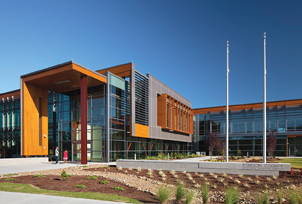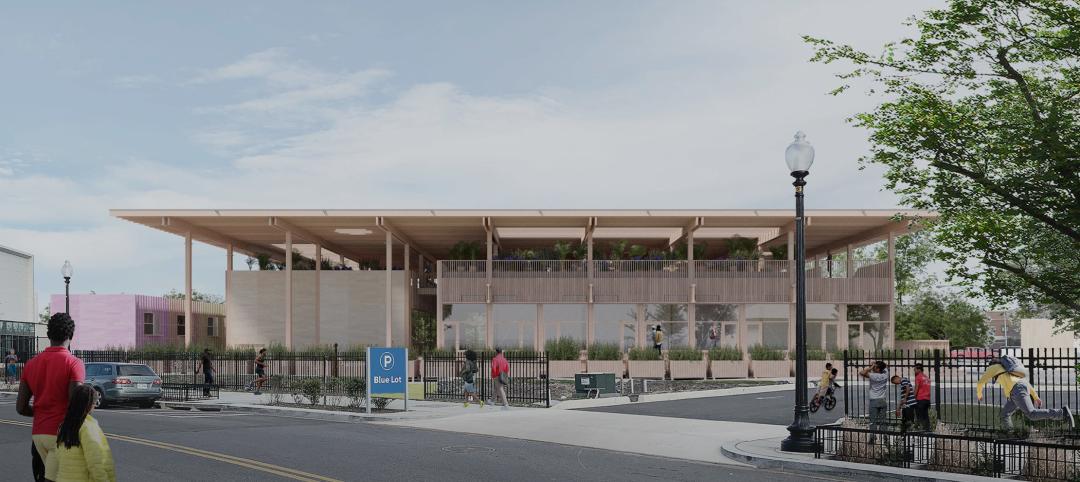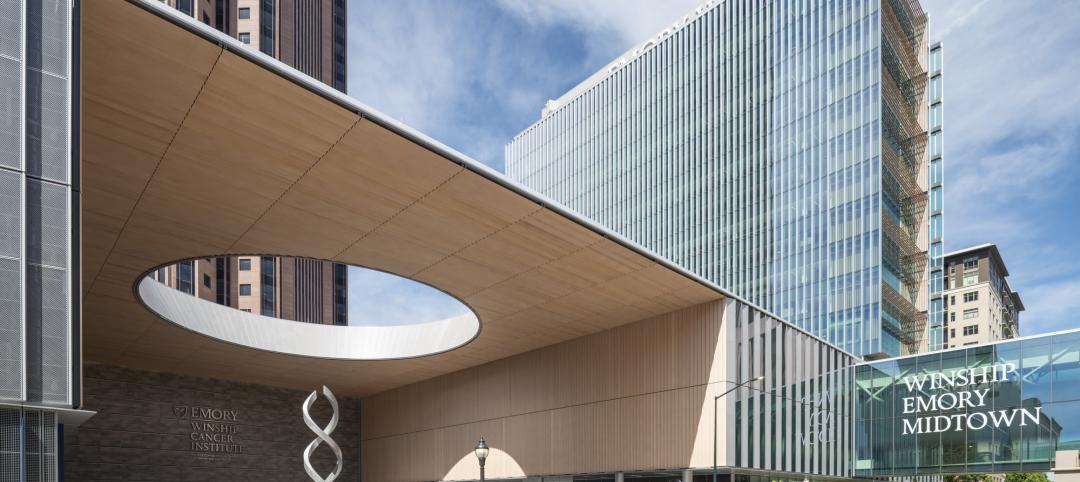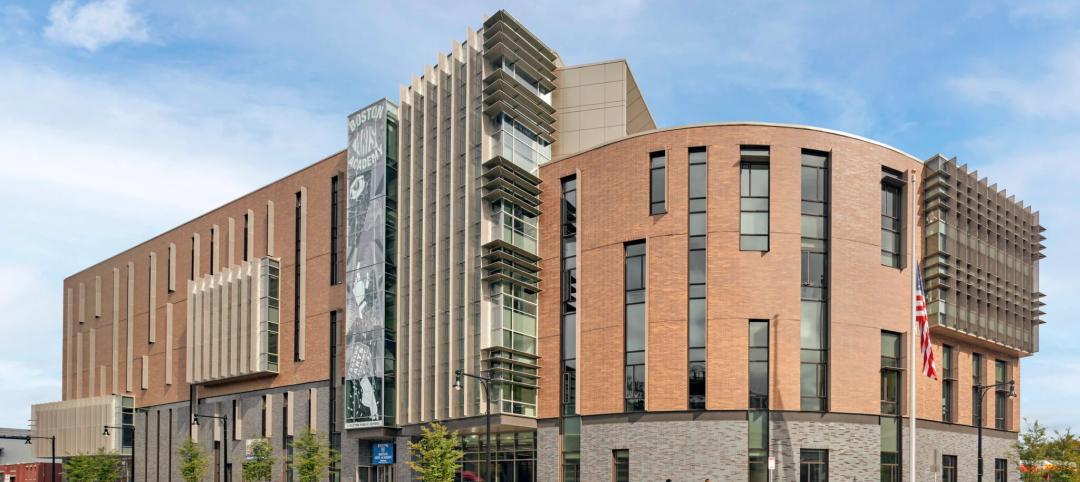Government work is scattered among dozens of federal civilian agencies, the Pentagon and the military branches, the 50 states, and tens of thousands of municipalities. The only thing these disparate entities have in common is a tight hold on their pocketbooks. With the federal stimulus having faded into the ether, and with state and municipal collections of sales and property taxes down, government construction at all levels will be slow to recover.“We’ll be lucky to see 2007 numbers by 2017,” says Margaret Bowker, Vice President, JE Dunn Construction.
Inside the Beltway, the GSA, the National Institutes of Health, the Naval Facilities Engineering Command, and the U.S. Army Corps of Engineers are still posting RFPs, but there’s a sense that “spending has been put on hold to wait and see the outcome of the election,” says Barry Perkins, LEED AP BD+C, Vice President – Government Construction, James G. Davis Construction Corp.“Certainly the size and type of projects has changed, with more smaller renovations and retrofits than larger new construction,” he says.
SCROLL DOWN FOR GIANTS 300 GOVERNMENT FIRM RANKINGS
“We’re showing up to prebids and competing against firms that never used to pursue city or county work,” says Dennis Thompson, Executive Vice President for Business Development, Manhattan Construction Co. “Competition has increased five- or six-fold, so you see an erosion of fees.”
The result: “You have the same firms chasing a smaller pool of projects,” says Len Vetrone, Webcor Builders’ Senior Vice President for Public and Federal Work.
MAKING THE ADJUSTMENT TO GOVERNMENT WORK
For newbies to federal work, learning how to work with the bureaucracy can be an eye-opener. When the economy went into the tank in 2008, Pepper Construction Group took on its first two GSA projects—the renovation of the Mies van der Rohe-designed John C. Kluczynski Federal Building, in Chicago, and the John Weld Peck Federal Building, in Cincinnati.
“There’s just an enormous amount of paperwork, forms, and protocols that are required on government jobs compared to our private work,” says Senior Vice President Rich Tilghman, PE. “We have high-quality teams with lots of experience renovating large buildings in the private sector, and GSA recognized that,” he says, adding that the $100 million in revenue for the two projects was certainly welcome.
Even firms with decades of federal civilian and military experience have to keep constantly attuned to client needs. Reynolds Smith & Hills has been designing and maintaining facilities for NASA for 50 years. Recently, the firm replaced almost 10,000 square feet of windows in the Launch Control Center at the Kennedy Space Center, a highly sensitive project. “NASA is a wonderful client, always looking for innovative solutions, but you have to create a low-risk environment for them,” says RS&H Vice President Richard Hammett, AIA, LEED AP.
Public-private partnerships are “starting to catch on” at the state and local level, says Webcor Builders’ Vetrone. “We’re talking to some of the cities we work for in California which have major public projects with no funding, looking at how P3 could make those a reality,” he says. A recently awarded P3 for a courthouse in Long Beach has attracted a lot of interest from the local AEC community, he says.
Manhattan Construction’s Thompson says privatization seems to be gaining traction with some federal clients. His firm is serving as contracting partner in such a developer leaseback scheme for a VA clinic in Grand Rapids, Mich., with U.S. Federal Properties.
SOME BRIGHT SPOTS ON THE HORIZON
Even with budget cuts, there will still be public-sector jobs for AEC firms. For example, Webcor Builders’ Vetrone reports “a fair amount” of aviation projects in California. “The big work at LAX and Sacramento has been awarded, but SFO still has a fairly aggressive program,” he says.
Manhattan Construction’s Thompson says some state and local government agencies may be rethinking their procurement policies because “service and delivery quality have been affected” by their reliance on super-low bidders. “The trend is back to technical qualifications plus low price, but at least it’s not just low price,” he says.
Vetrone says Webcor Builders is being “pretty selective” as to which government projects it bids on. “We’re looking for clients who want to hire on a best-value basis, whether design-build or CM at risk, where your qualifications, technical competence, and people count as much as your price,” he says.
More commissioning of government and military buildings could also be a godsend for AEC firms. “We’ve done enhanced commissioning for the Air Force, and we’re finding that the buildings have a marked increase in performance,” says RS&H’s Hammett. “If anything was a no-brainer, commissioning would be it.”
Portfolio optimization is becoming much more important to governments at all levels, as they seek to reduce overhead while improving employee productivity. “They’re looking for a trifecta—asset preservation, sustainability, and innovative workplace solutions,” says Becky Greco, Principal, HGA Architects and Engineers. Public-sector clients want to emulate the corporate model of “better, faster, more cost-efficient,” she says.
Lisa Bottom, a Principal at Gensler, agrees. “Government workplaces are moving away from a hierarchical structure and embracing an open plan” based on actual space usage and employee mobility patterns, she says. The goal: flexible offices that will meet current and future needs of the workforce at all levels of government. +
TOP 25 GOVERNMENT SECTOR ARCHITECTURE FIRMS
| Rank | Company | 2011 Government Revenue ($) |
| 1 | HOK | 143,334,571 |
| 2 | Heery International | 103,832,000 |
| 3 | SmithGroupJJR | 77,652,837 |
| 4 | IBI Group | 57,347,163 |
| 5 | Perkins+Will | 48,059,661 |
| 6 | HDR Architecture | 46,000,000 |
| 7 | EYP Architecture & Engineering | 40,892,580 |
| 8 | Skidmore, Owings & Merrill | 33,907,000 |
| 9 | HNTB Architecture | 31,338,712 |
| 10 | PageSoutherlandPage | 27,263,377 |
| 11 | NBBJ | 24,958,000 |
| 12 | LEO A DALY | 24,141,694 |
| 13 | Hammel, Green and Abrahamson | 24,028,000 |
| 14 | PGAL | 24,018,100 |
| 15 | Reynolds, Smith and Hills | 18,900,000 |
| 16 | ZGF Architects | 17,653,791 |
| 17 | RTKL Associates | 17,075,180 |
| 18 | DLR Group | 17,000,000 |
| 19 | Gensler | 17,000,000 |
| 20 | Moseley Architects | 13,700,000 |
| 21 | Beyer Blinder Belle Architects & Planners | 12,450,000 |
| 22 | Sasaki Associates | 12,356,441 |
| 23 | Cannon Design | 12,000,000 |
| 24 | KMD Architects | 11,913,372 |
| 25 | Fentress Architects | 11,830,262 |
TOP 25 GOVERNMENT SECTOR ENGINEERING FIRMS
| Rank | Company | 2011 Government Revenue ($) |
| 1 | AECOM Technology Corp. | 2,485,000,000 |
| 2 | Fluor Corp. | 1,127,862,000 |
| 3 | Jacobs | 924,100,000 |
| 4 | URS Corp. | 309,987,000 |
| 5 | STV | 133,396,000 |
| 6 | Stantec | 117,000,000 |
| 7 | Dewberry | 57,006,253 |
| 8 | Atkins North America | 43,330,846 |
| 9 | Parsons Brinckerhoff | 35,515,523 |
| 10 | H&A Architects & Engineers | 31,641,856 |
| 11 | Michael Baker Jr., Inc. | 30,830,000 |
| 12 | Science Applications International Corp. | 15,431,116 |
| 13 | Walter P Moore | 12,531,123 |
| 14 | Coffman Engineers | 12,400,000 |
| 15 | SSOE Group | 12,321,198 |
| 16 | WSP USA | 10,900,000 |
| 17 | Arup | 10,580,870 |
| 18 | TLC Engineering for Architecture | 8,528,328 |
| 19 | Sebesta Blomberg | 8,450,225 |
| 20 | Interface Engineering | 8,103,067 |
| 21 | Walker Parking Consultants | 7,887,763 |
| 22 | Simpson Gumpertz & Heger | 7,800,000 |
| 23 | KPFF Consulting Engineers | 7,000,000 |
| 24 | RMF Engineering | 7,000,000 |
| 25 | Wiss, Janney, Elstner Associates | 6,936,000 |
TOP 25 GOVERNMENT SECTOR CONSTRUCTION FIRMS
| Rank | Company | 2011 Government Revenue ($) |
| 1 | Turner Corporation, The | 2,268,320,925 |
| 2 | Jacobs | 924,100,000 |
| 3 | Clark Group | 850,491,577 |
| 4 | Whiting-Turner Contracting Co., The | 749,080,537 |
| 5 | Gilbane Building Co. | 736,199,000 |
| 6 | Hensel Phelps Construction | 669,080,000 |
| 7 | Walsh Group, The | 552,751,904 |
| 8 | Skanska USA | 550,758,448 |
| 9 | Webcor Builders | 484,567,966 |
| 10 | Tutor Perini | 385,311,000 |
| 11 | Balfour Beatty US | 341,774,742 |
| 12 | URS Corp. | 309,987,000 |
| 13 | Manhattan Construction Group | 274,683,334 |
| 14 | Alberici Corp. | 247,423,509 |
| 15 | PCL Construction Enterprises | 245,007,223 |
| 16 | Mortenson | 233,863,000 |
| 17 | Flintco | 223,200,000 |
| 18 | McCarthy Holdings | 218,000,000 |
| 19 | James G. Davis Construction | 208,000,000 |
| 20 | Yates Companies, The | 187,800,000 |
| 21 | Ryan Companies US | 156,858,437 |
| 22 | DPR Construction | 146,889,203 |
| 23 | JE Dunn Construction | 135,637,557 |
| 24 | Sundt Construction | 100,393,850 |
| 25 | CORE Construction | 94,340,532 |
Related Stories
Retail Centers | Jun 2, 2023
David Adjaye-designed mass timber structure will be a business incubator for D.C.-area entrepreneurs
Construction was recently completed on The Retail Village at Sycamore & Oak, a 22,000-sf building that will serve as a business incubator for entrepreneurs, including emerging black businesses, in Washington, D.C. The facility, designed by Sir David Adjaye, the architect of the National Museum of African American History and Culture, is expected to attract retail and food concepts that originated in the community.
Mixed-Use | Jun 1, 2023
The Moore Building, a 16-story office and retail development, opens in Nashville’s Music Row district
Named after Elvis Presley’s onetime guitarist, The Moore Building, a 16-story office building with ground-floor retail space, has opened in Nashville’s Music Row district. Developed by Portman and Creed Investment Company and designed by Gresham Smith, The Moore Building offers 236,000 sf of office space and 8,500 sf of ground-floor retail.
Healthcare Facilities | Jun 1, 2023
High-rise cancer center delivers new model for oncology care
Atlanta’s 17-story Winship Cancer Institute at Emory Midtown features two-story communities that organize cancer care into one-stop destinations. Designed by Skidmore, Owings & Merrill (SOM) and May Architecture, the facility includes comprehensive oncology facilities—including inpatient beds, surgical capacity, infusion treatment, outpatient clinics, diagnostic imaging, linear accelerators, and areas for wellness, rehabilitation, and clinical research.
K-12 Schools | May 30, 2023
K-12 school sector trends for 2023
Budgeting and political pressures aside, the K-12 school building sector continues to evolve. Security remains a primary objective, as does offering students more varied career options.
Multifamily Housing | May 30, 2023
Boston’s new stretch code requires new multifamily structures to meet Passive House building requirements
Phius certifications are expected to become more common as states and cities boost green building standards. The City of Boston recently adopted Massachusetts’s so-called opt-in building code, a set of sustainability standards that goes beyond the standard state code.
Architects | May 30, 2023
LRK opens office in Orlando to grow its presence in Florida
LRK, a nationally recognized architectural, planning, and interior design firm, has opened its new office in downtown Orlando, Fla.
Urban Planning | May 25, 2023
4 considerations for increasing biodiversity in construction projects
As climate change is linked with biodiversity depletion, fostering biodiverse landscapes during construction can create benefits beyond the immediate surroundings of the project.
K-12 Schools | May 25, 2023
From net zero to net positive in K-12 schools
Perkins Eastman’s pursuit of healthy, net positive schools goes beyond environmental health; it targets all who work, teach, and learn inside them.
Contractors | May 24, 2023
The average U.S. contractor has 8.9 months worth of construction work in the pipeline, as of April 2023
Contractor backlogs climbed slightly in April, from a seven-month low the previous month, according to Associated Builders and Contractors.
Mass Timber | May 23, 2023
Luxury farm resort uses CLT framing and geothermal system to boost sustainability
Construction was recently completed on a 325-acre luxury farm resort in Franklin, Tenn., that is dedicated to agricultural innovation and sustainable, productive land use. With sustainability a key goal, The Inn and Spa at Southall was built with cross-laminated and heavy timber, and a geothermal variant refrigerant flow (VRF) heating and cooling system.

















